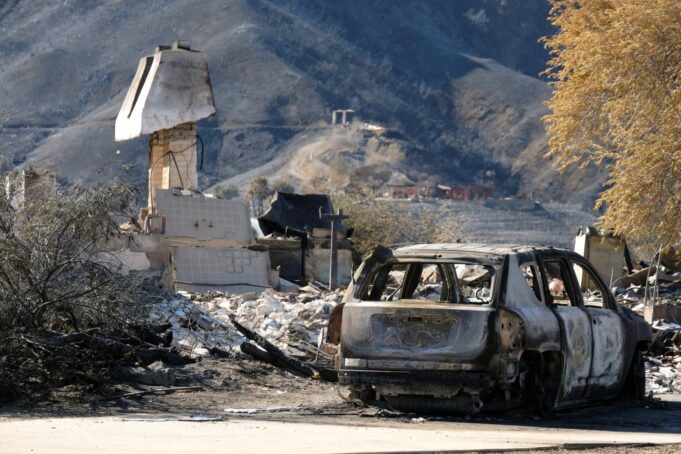Steve Scauzillo
Climate change, high temperatures and dry brush prompted Southern California fire chiefs to declare the early start of fire season on Thursday, June 9, warning homeowners to get ready for what could be an extended fire year.
With that, the debate rages about what is the best way for hundreds of thousands of homeowners living near wildlands, hillsides, mountains and canyons to protect themselves and their property from increasingly ferocious wildfires that can burn hotter than usual and spread quicker.
For decades, local and state firefighting agencies have emphasized creating a “defensible space” around homes by clearing away brush that may act as fuel. But that idea has come under attack by many scientists who have studied the “new normal” in fires that are wind-driven and carry embers in the air from as far away as two miles from the fire front.
“People think fires operate only by burning materials near them and if you clean out that material around a house you will be safe,” began Rick Halsey, director of the California Chaparral Institute based in northern San Diego County and a wildfire ecologist, in an interview Thursday.
But Halsey has a stunning message: “Virtually no homes ignite that way.”
Halsey and others have studied fires such as the Camp Fire in November 2018 in the Sierra Nevada foothills that killed 85 people and destroyed about 19,000 homes and businesses while wiping out the town of Paradise. He also looked at the Woolsey Fire occurring around the same time that burned 96,949 acres in Los Angeles and Ventura counties, killing three people and destroying 1,643 structures.
In both fires, homes whose owners had cleared the surrounding space still burned, he said.
“Defensible space when you have wind-drive fires doesn’t work,” Halsey said. “The only way to reduce ignition it to reduce the flammability of the house itself.”
How do you do that? It’s called “hardening your home” and it involves several techniques — some that can cost thousands of dollars — that can make a home less likely to burn, he said.
In short, Halsey and others studying wildfires operate under the premise: fires occur in wildfire corridors, often repeating the cycle every so many years, so adapting is the key. People who live in these fire zones should concentrate on home hardening, not clearing brush.
The Los Angeles County Fire Department still advocates clearing brush from 30 to 100 feet out from the property — the distance depending on proximity to wild lands and other factors, said Craig Little, department spokesman.
“You want to thin it out and decrease the availability of fuels,” he said. Halsey says not only is the official advice not effective when a spark comes from the sky, not the ground, but it can make a house more vulnerable, not less, by giving the fire and its embers a path to spread.
A study from the International Journal of Wildland Fire in 2012 concluded “when a fire front hits a bare fuel break or clearance area, a shower of embers are often released.”
Often, homeowners become too vigilant by scraping the vegetation to the bare earth, destroying the native chaparral. That invites invasive weeds, such as mustard, that are more flammable, Halsey said.
The California Chaparral Institute , along with the Center For Biological Diversity, take issue with Cal Fire, the state fire agency, which is planning 10 million acres of vegetation thinning in mountains and desert regions as a means of fire prevention. The groups have sued Cal Fire, saying this will not be effective during wind-driven fires and will result in loss of habitat for wild animals.
Instead of focusing on the wildlands and brush, Halsey’s group and others promote fire prevention from the structure or house. One key element Halsey advocates is roof sprinkler systems . He’s installed them at his own home along the roofline corners. His system saturates the roof and eaves in 30 minutes.
“The secret is wet homes don’t ignite,” Halsey said.
A system with a separate, 5,000-gallon water tank may cost between $6,000 and $7,000. But Halsey said communities can work together and share the cost by connecting to one tank.
He said Gov. Gavin Newsom last year put $1 billion into the state budget for fire prevention, but only about $5 million of that went toward home hardening. Halsey advocates homeowner grants or low-interest loans. These practices are more common in Australia and Canada, he said.
An old, wooden visitor center within Malibu Creek State Park survived the effects of the Woolsey Fire because it had roof sprinklers, he said.
Home hardening has begun seeping into preparedness messages in local departments. An L.A. County Fire video on its website fire.lacounty.gov includes home hardening tips such as the following:
• Enclosing rain gutters by plugging the gap between the roof decking and covering
• Cover roof or attic vent openings with one-eighth inch metal mesh and use baffles to block any embers
• Large, single-pane windows are vulnerable to fire. Replace them with dual pane windows with the exterior pane made of tempered glass
• Replace wood siding with non-flammable brick, cement, masonry or stucco
• Secure patio chairs to the deck so they don’t get airborne in a fire. If building a new deck, use non-flammable materials. Enclose undersides of balconies and decks with fire-resistant materials
“Also, you want a roof that doesn’t have wood shingles,” Little said. “Spanish tiles is great because they are non-flammable.”
L.A. County Fire advocates using all methods for homes within the urban-wildland interface. But nothing is foolproof.
“Creating a defensible space and hardening your home is the equivalent to wearing your seatbelt in a car: It reduces your chance of being injured in an accident. But it is not a guarantee,” Little said.
Related links
Woolsey fire destroys 435 structures, 40 percent contained
State closes criminal probe of 2018 Woolsey Fire
Woolsey fire containment reaches 30 percent — winds still feared as federal aid is approved
Scientists challenge conventional wisdom on preventing home loss during wildfires
Is it possible to build fire-resilient communities in a fire-risk state?











